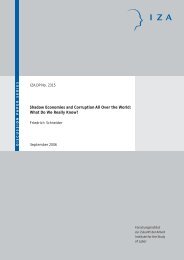Immigration: High Skilled vs. Low Skilled Labor? - Iza
Immigration: High Skilled vs. Low Skilled Labor? - Iza
Immigration: High Skilled vs. Low Skilled Labor? - Iza
Create successful ePaper yourself
Turn your PDF publications into a flip-book with our unique Google optimized e-Paper software.
of low-skilled labor. <strong>High</strong>-skilled immigration thus decreases the burden of low-income natives<br />
on the welfare state.<br />
Although some natives gain and other natives lose, immigration can increase the total<br />
income of the native (pre-migration) population. To simplify the exposition, consider the graph<br />
in Figure 1 showing the marginal product of low-skilled labor from the aggregate production<br />
function. The greater the amount of low-skilled labor, the lower is its marginal product (wage<br />
rate). <strong>Skilled</strong> workers and capital are aggregated into a single factor of production, referred to as<br />
all other factors, that determines the height of the marginal product curve.<br />
Initially there are S0 low-skilled workers, so the gross domestic product (GDP) is shown<br />
by the area OABC, of which OW0BC is the return to low-skilled native workers (OW0 is the<br />
earnings per worker) and W0AB is the return to the other factors of production – high-skilled<br />
workers and capital. With the immigration of I workers, the low-skilled labor supply curve shifts<br />
from S0 to S1, and the wage rate of low-skilled workers falls to W1. The total wages of low-<br />
skilled native workers has declined to OW1GC and the total income of other factors of<br />
production has increased to W1AD. Since other factors are assumed fixed in the short run, the<br />
rate of return to skilled workers and to physical capital has increased. Thus low-skilled native<br />
workers lose income and the owners of other factors gain, but the aggregate income of the native<br />
population increases by BDG. The immigrants gain; although the wage in the destination has<br />
declined, it is presumably still higher than the wage available in the origin.<br />
Public policies may be evaluated in terms of their impacts on the level or rate of growth<br />
of income and their impacts on the personal or functional distributions of income. Social welfare<br />
is generally said to increase with an increase in the level or the rate of growth of income, and to<br />
increase with a decline in inequality in the distribution of income. Since income distribution<br />
5
















